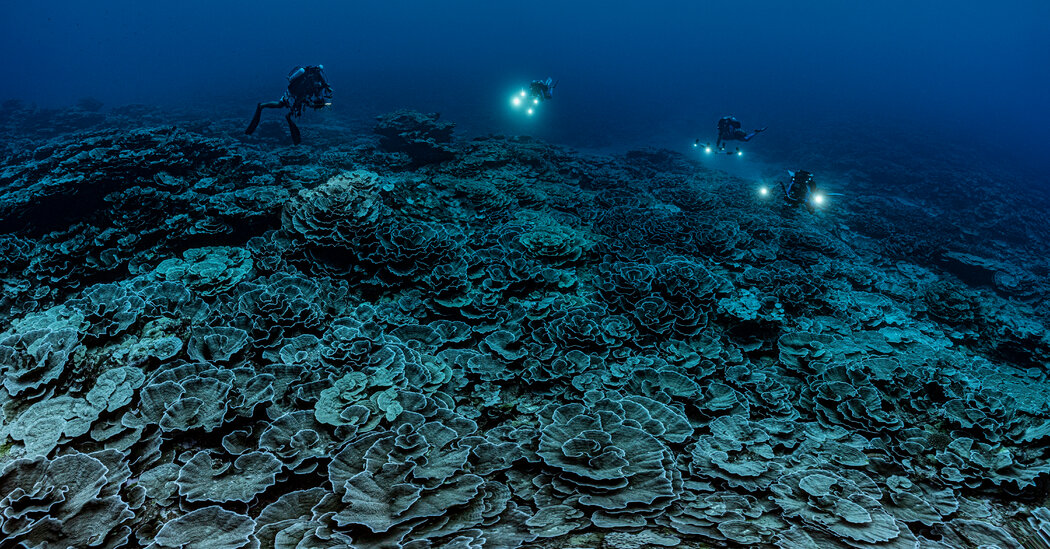The reef, which is just under two miles long and is in “pristine” condition, was found by a team of divers mapping the ocean floor for UNESCO.
An underwater mapping project recently took an unexpected twist off the coast of Tahiti, where deep sea explorers said this week that they had discovered a sprawling coral reef resembling a bed of roses that appeared to be largely unscathed by climate change.
Extending for about three kilometers (1.86 miles), the reef is remarkably well preserved and is among the largest ever found at its depth, according to those involved in the mapping project sponsored by UNESCO, the U.N. Educational, Scientific and Cultural Organization.
Some even described the condition of the reef, hidden at depths between 30 meters (about 100 feet) and 100 meters in the crystalline waters of the South Pacific, as “pristine.”
Alexis Rosenfeld, an underwater photographer from Marseille, France, said on Thursday that the reef lived up to what he had envisioned when he first explored it shortly after its discovery in November.
“This, my dream, is exactly the same as the reality,” Mr. Rosenfeld said of the reef, which is about two kilometers off the shore.
Mr. Rosenfeld, 52, photographed the reef as part of a deep sea exploration project called 1 Ocean, partnering with UNESCO and researchers from CRIOBE, a prominent French laboratory specializing in the study of coral reef ecosystems, and the French National Centre for Scientific Research.
The reef occupies an area of the ocean known as the mesophotic zone — from the Greek words for middle and light — where the algae that coral depends on for survival can still grow but where light penetration is significantly diminished, scientists said.
Unlike coral reefs found at shallower depths, which are often shaped like branches and are more susceptible to being damaged by rising ocean temperatures, scientists said, mesophotic reefs form their floral shape to gain more surface area and receive more light. To capture images in low-light conditions, Mr. Rosenfeld said he used a Sony Alpha 1, a mirrorless full-frame camera.
Julian Barbière, the head of the Marine Policy and Regional Coordination Section for the Intergovernmental Oceanographic Commission at UNESCO, said on Thursday that he was blown away by the expanse of rose petals captured in the photos.
“You can see them as far as the eye can see,” he said. “When they came back and showed the pictures, we were really amazed by the quality of the ecosystem there.”
Mr. Barbière noted that climate change posed a significant threat to coral reefs, especially those at shallower depths, like the ones damaged in recent years in the South Pacific in what is known as bleaching. As part of that process, coral loses its color and its skeleton is exposed.
“That can destroy or really impact the coral reef,” he said.
Reaching the coral reef presented a particular challenge to scientists and photographers because of its depth, those involved in the project said. It required them to use special breathing equipment and a mixture of gases that contained helium, they said.
John Jackson, a film director with 1 Ocean who is involved with the project, compared the reef’s shape to lacework. In an interview on Thursday, he said that significant work remained when it came to underwater exploration, pointing out that only about 20 percent of the world’s seabeds had been mapped.
“We know every detail of Mars, every detail of the moon and certain planets,” Mr. Jackson said.
Richard Norris, a professor of paleobiology at the Scripps Institution of Oceanography at the University of California, San Diego, who was not involved with the project, said on Thursday that the discovery was gratifying.
“Tahiti is nice because it’s far from sediment sources on land where the water could end up being cloudy and making it harder for the algae to grow in these deep water reefs,” Professor Norris said.
He likened the relationship between coral and algae to that of the human body and yeast, saying that it was critical to maintain a delicate balance.
“If they get stressed by, for example, unusually warm temperatures, then it turns a symbiotic relationship with the algae to one that is antagonistic, where the algae damage the coral and the coral gets rid of them,” Professor Norris said.
Once the reef and the marine species that call it home are better understood, those involved in the project said that they would seek to adopt conservation measures to protect the ecosystem.
“Without exploration,” Mr. Rosenfeld said, “you can’t have science.”































